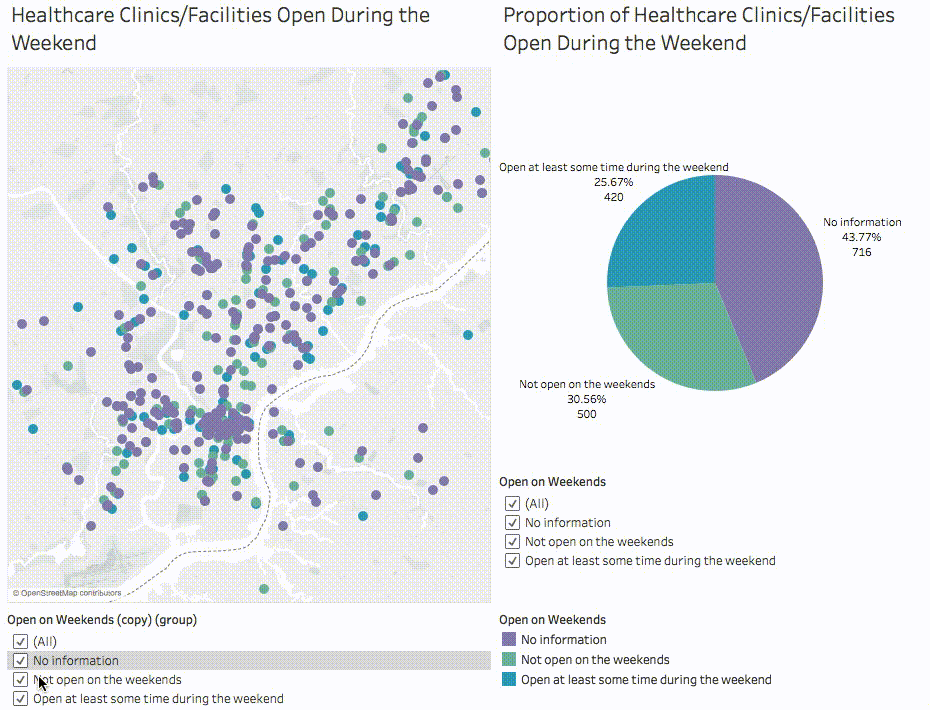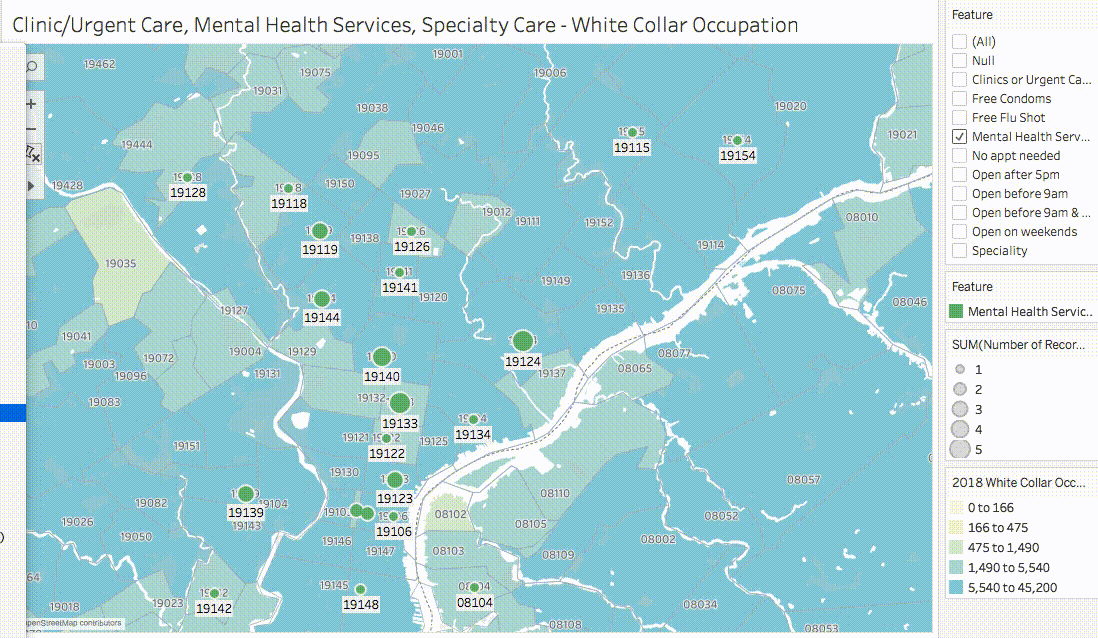
Convenient Access to Healthcare in Philadelphia
Melinda Hu's Data Project 1 for Wharton's OIDD 245 Course
As a Penn student interested in healthcare and tech (more about me here), I wanted to focus this project on how millennials, a big subset of Amazon’s employees, care about accessing healthcare in convenient ways. Philadelphia, home to the top medical institutions in the world, seems to provide easy access to healthcare for these young, busy, no-fuss millennial employees.

Why healthcare?
Outside of Amazon’s pursuit in the healthcare space with (1) its joint venture with J.P. Morgan and Berkshire Hathaway and (2) its plans to open health clinics for its employees, today’s millennial workers simply do care about their health. They’re quite possibly more open about their health issues than previous generations were.
Those in the tech industry are especially concerned about work-life balance. However, how millennials prefer to access healthcare is different from previous generations. Now, it’s not unusual for a young person to not have a primary care provider (PCP) that they always go to for their health issues.
Unlike their parents, more millennials are using retail clinics, urgent care centers (acute care clinics), or emergency rooms for nonemergency care. They prefer these walk-in clinics and medical centers because they don’t require much planning in advance and are open in the evenings and weekends. In other words, they’re more convenient. They don’t really want to see doctors unless they have to, and when they do, cost is their biggest concern.

Data Sources
After the trials and tribulations of trying to scrape all the results to the search “medical clinic” on Yelp, I discovered that Yellow Pages had more search results. After having more successful scraping here, I decided to use just Yellow Pages to find information on Philadelphia’s healthcare providers. Using Web Scraper, I scraped 1,500+ results for name, address, hours and days open, services offered, and additional information (e.g. whether appointment was needed) in response to the search “medical clinic” in Philadelphia, PA.
I did a considerable amount of data-cleaning in Excel, as the hours and days open, as well as services offered and additional information, could only be scraped in a group. To tease out the data I needed, I created new columns, including: Open Before 9am, Open After 5pm, Open on the Weekends, Open 24/7, Appointment Needed, Urgent Care/Clinic, Specialty Doctor, and more.
To do this, I used =IF(OR(ISNUMBER(SEARCH(___, ___), ISNUMBER(SEARCH(___, ___)))__, __) frequently to code whether something was true or false for each of the columns. Each cell’s value in these columns was a 0, 1, or null (if that information wasn’t given in the scraping result, a.k.a. not on the website). I also used Geocodio to convert addresses into longitudes and latitudes. Find V1 of my cleaned data here.
Then, considering millennial’s big concern with costs, I found 2 sources of clean data from Open Data Philly regarding free health resources: free flu shots and free condoms. I would later combine these data sets with the Yellow Pages one to graph them together.
Afterwards, I realized I made a mistake of not including zip codes in the cleaned CSV files of my data, so I had to use Tableau Prep to join the location data I got from Geocodio (which includes the zipcodes and more) to my health clinics and Open Data Philly data.
I created all my visualizations using Tableau Desktop.
Note: Many of the following images are GIFs - if they don’t load, please give them a moment (you should see my cursor moving and the visualization changing) or right-click and “Open Image in New Tab.” If they’re blurry, here are the original MOV files. Thank you!

Providers Open Before 9am
Millennials could squeeze in a visit before going to work (since it’s Amazon, I wouldn’t imagine the start time to be earlier than 9am). It seems like clinics/offices that open before 9am are numerous (400+) and quite evenly distributed across Philadelphia. Almost half the clinics with hours-open data were open before 9am! Nonetheless, many of the clinics listed on Yellow Pages didn’t have hours/days open posted.

Providers Open After 5pm
Once again, medical centers open after 5pm seem to be quite evenly distributed, except for a possible clustering of medical centers that are not open after 5pm towards the center of the city. For the medical centers for which we have data on hours-open, 45% are open after 5pm.

Providers Open on the Weekends
Again, facilities open on the weekends are distributed across Philadelphia and beyond, but many seem clustered in the center of the city.

A few open 24/7
Only a dozen or so healthcare providers are open 24/7 in the Philadelphia area. It’s interesting to note that most of these 24/7 hour facilities are located far from the city center… (There are two in University City though!

Hotspots
Here, the size of the circle represents the number of healthcare providers in that zipcode that fit the time criteria (open before 9am on weekdays, after 5pm on weekdays, and/or on the weekend).
The map background is layered with information on the number of white collar workers in that zip code, which I’m assuming Amazon employees would fit under. It’s clear that areas with larger circles tend to be where white collar workers are living, indicating good access to healthcare. (A discussion on health equity will be for a later time…)
Click here to see each screenshot and specific zip codes.

In relation to housing units growth...
When I put the map layer indicating “Housing Units Growth 2018-2023,” I can see that the zipcode areas with the greater expected housing units growth coincide with nearby areas that have healthcare providers open at the convenient times. Thus, where people are expected to move into the city have the more convenient access to health services in terms of hours of operation.

Highlighted Types of Healthcare Services
Having scraped the tags of the kinds of healthcare services provided, I wanted to shed some light on what services were available that millennials in particular would want to access. For example, today, mental wellness has become an extremely important topic for the overworked, stressed younger generations - thus, having mental health services nearby and open would be important (*side glance at Amazon’s culture…). Another example would be walk-in clinics/urgent care and specialty doctors, since young people seem not to want to go to the doctor unless necessary (e.g. emergency or specific health issue, respectively).
Let’s dig into a couple of these components.


Are they really available?
Under half of the urgent care / health clinics that were labeled as such on Yellow Pages are open before 9am on weekday(s), after 5pm on weekday(s), or on the weekends.
Fortunately, it seems like more than half the mental health services providers are open before 9am on weekday(s) and/or after 5pm on weekday(s).

Clinic/Urgent Care, Mental Health, and Specialty
Plotting this on the graph, I noticed that there are high concentrations of specialty healthcare providers and urgent care clinics in center city, university city, and some relatively rich neighborhoods on the northern sides of Philadelphia county. But, it seems like more mental health services are available on the outskirts of Philadelphia county. This might not be a bad thing, as areas like Fishtown (getting to northern parts of Philly) are becoming more popular for millennials to find homes. Again, the backdrop of the map shows that the bigger circles (more such services) tend to be in zip codes where white collar workers reside.
Below, I did a quick screenshot on just mental health services, and once again, they seem to be located in zipcodes farther from center of Philly. But, the median age of these regions still seem to be in the 30s range, which might indicate that millennials could move there still.


In relation to housing units growth again...
When I put the map layer indicating “Housing Units Growth 2018-2023,” I can see that the zipcode areas with the greater expected housing units growth coincide with nearby areas that have more of these healthcare services. (I realize the purple “clinic/urgent care” circle overpowers the others, so here is the shot without “clinic/urgent care.”)

We're lazy and last minute...
Being able to walk into a clinic without an appointment seems like the most convenient thing possible (though it’s a logistical problem for these health clinics). Though not that many providers gave information on whether they required appointments or not (generally it’s assumed you need an appointment), I looked at areas that didn’t require appointments in advance.
Right now, it seems like Center City is the safest bet to find clinics that don’t require appointments. Millennials would frequent this area regardless for food and entertainment. So, if a new Amazon office opens in Center City, an unplanned appointment before or after work seems feasible.

Free things!
Going to the data from Open Data Philly, I plotted the providers that offered free condoms every day, 24/7, and after 5pm. It seems like a couple providers open 24/7 are near areas with high populations (main city parts of Philadelphia), and it seems that most are open every day.
I also plotted the providers that offered free flu shots (during flu shot season) before 9am and after 5pm (before and after work). It seems like there tend to more locations that offer free flu shots before 9am.
Below are maps confirming that hotspot areas (University City, Center City, some northern areas of Philly) have more places that offer these free things, and match the white collar worker / millennial age characteristics.



So...
As I mentioned in the introduction, millennials really value convenient, low-cost health services. Here’s one last simplified map to show just 3 of places that millennials might access for such services.
All in all, Philadelphia is well suited for these millennials to access health services for themselves and their families. Although the situation isn’t perfect in all zip codes, the areas that these employees will likely move to or spend time in are accessible based on the analysis I did.
Thank you!